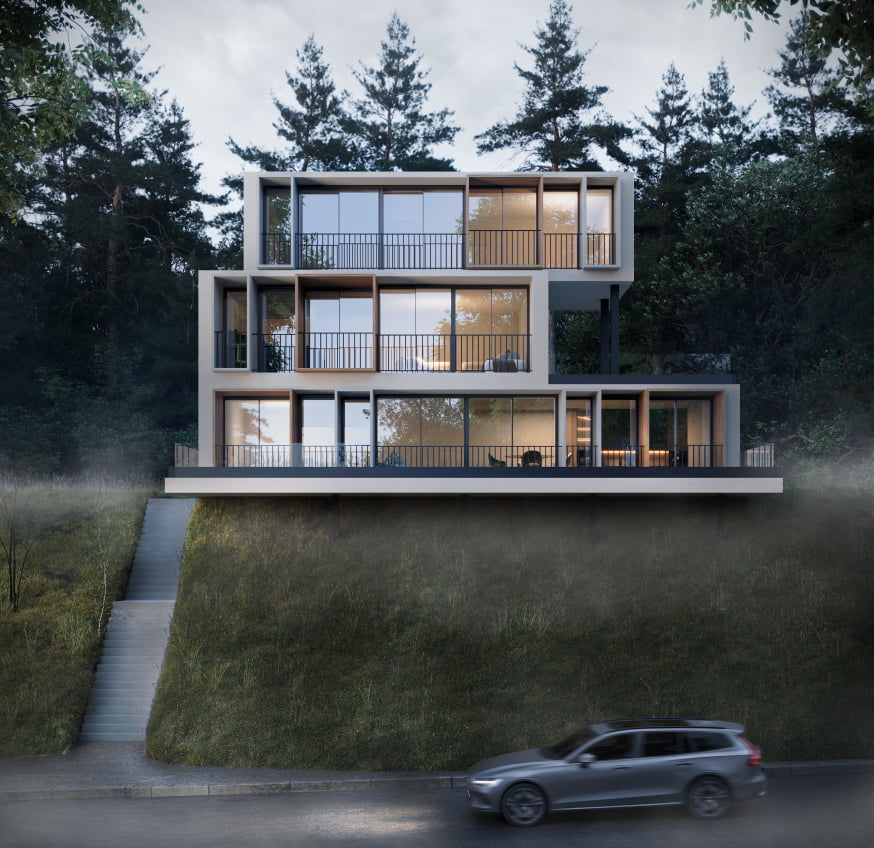Post-processing renders in Photoshop: features and hacks


Seeking 3D Visualization for Your Project?
The process of transforming a three-dimensional model into a flat image (rendering) is a delicate art. Configuring the camera in a specialized program and selecting the right perspective with resolution parameters set to emphasize the ceramic granite apron in the kitchen is not always sufficient. A perfectly executed project is achieved after post-processing, where tools like the lasso, brushes, pens and pencils in Photoshop play a crucial role in creating a finished image.
Post-processing – the final touchPost-processing – the final touch
This is the concluding step in creating architectural or interior visualizations. At this stage, 3D artists craft the desired atmosphere eliminating flaws in uneven lighting or shadows. They also play with depth of field parameters to convey realism making the image more detailed.
Photoshop remains the most versatile program for such purposes. However, the arsenal for post-processing can also be applied in real-time directly in the same program used for modeling. For instance, in 3D’s Max, the interactive LightMix feature can be a lifesaver (render once change colors a million times as desired).
Have you ever pondered what connects the process of developing processed film photographs and rendering images of a future townhouse building? The answer. A lot of invested time!
Even after the resurgence of analog “cards” and unprecedented technological progress the precious minutes to achieve success have remained nearly the same. But this is, for the most part, an objective reality (if we don’t delve into the magic of “powerful” software).
However, this factor is not as intimidating as the loss of time X2. Digitized frames often bear the defects of incorrectly set ISO or the evident work of an amateur who mishandled the film leaving mechanical damages.
Similar artifacts can be observed in visualizations of bathroom interiors or facades of gym buildings. Correcting them in post-processing is the same time spent X2. And also…
Moreover, the render that a 3D artist prepares for presentation to the client may differ from the one the client will ultimately see. In visualizations of a living room you can apply the color of pink sand as a wall covering as specified in the requirements. However, on one computer color reproduction becomes tangible evidence, while on another it may seem like blatant disregard for preferences. And the culprit is not the visualizer staging a imaginary boycott but the simple (not so simple!) color reproduction of the monitor.
Types of defects in renders
Types of defects in renders
Pixelation
Imagine pixels as people commuting to work on a crowded bus in the morning rush hour. Due to heavy traffic, there’s no fear of falling when the bus abruptly stops because everyone will brace themselves in the cramped space. Similarly, pixels of similar colors behave when improperly processed during compression forming noticeable visual blocks. They distort the image and tarnish the reputation of the 3D artist.
Moiré patterns
Luxurious silk dresses made from moiré fabric can change shade depending on the lighting. In everyday life such effect is observed when children blow soap bubbles and adults deal with the cause of a car breakdown leaving drops of gasoline in puddles after rain. The interaction of these two liquids with sunlight forms a thin film where all the colors of the rainbow appear. This phenomenon is called interference. It can also occur in the digital world when the resolution is incorrectly set during rendering.
Chromatic aberration
It’s intentionally applied for rendering characters in video games to conceal technical stylized flaws. In architectural rendering additional color fringe caused by beam distortion is unacceptable (unless it’s set to a very small value, imperceptible to the human eye but transmitted at the level of sensations).
The reasons why an image may turn out to be of poor quality during post-processing after rendering are twofold. The resolution reduction during compression and excessive use of sharpening functions (or others like high exposure or improperly set camera), which as a “bonus” give the modeled house a rainbow halo all around its shape.
Features of post-processing in Photoshop
Features of post-processing in Photoshop
After rendering images many things can perplex and present new challenging tasks to visualizers or designers. Suddenly, “floating” cups above the kitchen table an uncharacteristically dark Scandinavian interior for a major client and black spots appearing out of nowhere can spoil the impression of what’s been seen. In such cases, the universal program – Photoshop – comes to the rescue. And to reduce noise from 5% to 2% when facing tight project deadlines you need not only to know how to use the myriad capabilities of this miraculous software but also to properly prepare renders for post-processing when migrating from 3D’s Max.
How to prepare a render before post-processing:
How to prepare a render before post-processing:
- The render should contain maximum information about the image content – avoid uninformative dark spots or, conversely, overexposed areas on the ceiling from the main light source coming from the window
- The render should be in high resolution so that Photoshop has enough information to process it
- Save the render in uncompressed formats like TIFF or PNG
Life hacks for post-processing
Life hacks for post-processing
Render elements
The use of additional layers in the main render enhances the image quality through various effects. These include layers that help highlight individual interior objects by color simplifying work and saving time. There is also a depth function (more often applied to exteriors) and the magical CTexmap (makes seams like sofa folds more realistic).
Plugin application
The most common plugin considered is the one built into Photoshop called Camera Raw. It has numerous settings that are adjusted with sliders. One important function is the correction of white/black balance and exposure increase/decrease. It’s recommended to use the “textures” option cautiously (transforms the interior into a well-detailed image) to avoid unnecessary noise in the background.
Blending modes
Light, shadow and color correction can be adjusted using regular curves or by duplicating layers from the same perspective. By aligning one render over another and applying a lighting/darkening effect to the top image, a better natural effect can be achieved.
Presets Usage
A time-saving hack. Instead of a 15-minute post-processing job, rendering can be done in just a second. A set of ready-made solutions such as a sky for architectural visualization backgrounds is a must-have!
Let’s summarize: the work of a visualizer in post-processing renders may not be limited to just the notorious Photoshop as any modeling software contains image correction tools. However, it all depends on the circumstances. The final step can be skipped either due to the limited time on the project, or… Or simply because the work will not require post-processing as the lighting, textures and materials will be of such high quality that they create the illusion of 100% photorealism.
SHARE THIS...

Elevate Your Project with 3D Visualization Expertise
Our other articles
Get in touch
The art of 3D visualization is our passion. We specialize in a wide range of services to bring
your ideas to life. In our arsenal, we have architectural rendering, interior visualization, 3D product visualization, 360-degree panoramas, virtual reality (VR), architectural animation, rendering
for metaverses, and many other capabilities.
If you’re looking to elevate your business with stunning visualizations, simply fill out the form below. Our team will get in touch with you shortly to kickstart work on your project. Let’s collaborate to create visualizations that will amaze your clients and help you achieve your goals.
Contact us







